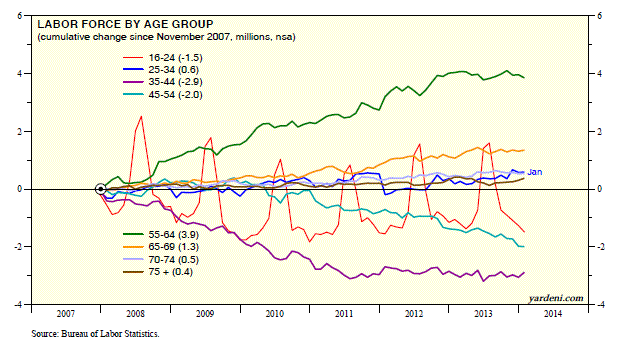
In her congressional testimony last week, Fed Chair Janet Yellen strongly suggested that the recent decline in the unemployment rate may be a more accurate indicator of a tightening labor market than previously thought. Many economists have said that the falling labor force participation rate (LFPR) may be exaggerating the improvement in the unemployment situation. Yellen said that the drop in the LFPR in recent years may be more structural than cyclical:
“A significant part of the decline in labor force participation is structural and not cyclical. Baby boomers are moving into older ages where there is a dramatic drop off in labor force participation and (with) an aging population we should expect to see a decline in labor force participation... There is no doubt in my mind that an important portion of this labor force participation decline is structural. That said, there may also be, and I am inclined to believe myself based on the evidence--that there are also cyclical factors at work. ... There is no sure-fire way to separate that decline into those components.”
She might be right, but the data tell a complex story. The LFPR peaked at a record high of 67.3% during January 2000. The big drop occurred since November 2007, which remains the record high for the household measure of employment. Since then, the LFPR has plunged from 66.0% to 63.0% at the start of this year. Let’s review the relevant data by age groups:
(1) Working-age population. Since November 2007, the working-age population is up 14.0 million, yet the labor force is up just 1.6 million. The number of people not in the labor force rose 12.4 million. The aging Baby Boomers are having a big impact on the age distribution of the working-age population. Since November 2007, the fastest-growing group is the 55- to 74-year-olds, up 12.6 million. The 35- to 54-year-olds group is down 3.5 million.
(2) In the labor force. The weak 1.6 million increase in the labor force since November 2007 can be explained mostly by the loss of 4.9 million workers in the 35- to 54-year-old group, offset by a gain of 5.7 million in the 55- to 74-year-olds.
(3) Not in the labor force. That older group tends to have a high labor force dropout rate due to retirements. Indeed, 6.7 million more of them were not in the labor force since November 2007 through January of this year.
On the other hand, that still leaves 5.5 million people younger than 55 who dropped out of the labor force over that same period. (The numbers don’t quite add up because the age group data are not seasonally adjusted as are the aggregate data.)
By the way, the Monetary Policy Report submitted by the Fed to Congress noted that while there might be structural explanations for the falling participation rate related to the aging of the Baby Boomers, the employment-to-population ratio remains very depressed. This suggests that “some of the weakness in participation is also likely due to workers’ perceptions of relatively poor job opportunities.”
Today's Morning Briefing: Paradigm Lost? (1) The “Fairy Godmother of the Bull Market” does it again. (2) Yellen promises continuity. (3) They didn’t have Bernanke & Yellen in 1929. (4) Yellen sees “soft data” and blames the weather. (5) Yellen says declining participation rate is structural. (6) Baby Boomers are dropping out. (7) Key labor stats Fed is watching. (8) Latest global indicators are mixed. (9) Performance Derby ytd. (10) “Non-Stop” (+).

